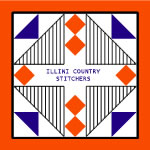Tips and Preservations
Textile Preservation Resources (Especially for Quilters)
Tips
Pencil Mark Removal 3 oz. rubbing alcohol 3 Tbsp. water 2-3 drops white Ivory dish soap Mix the above together in a bottle. Put quilt on absorbent surface (folded beach towel). Apply solution with an old soft toothbrush, and do not scrub with the bristles, unless it is really bad. It will dry in a few minutes and will not require rinsing. The solution will not go bad and can be stored in an upright bottle. NOTE: As always, try this in an inconspicuous part of the quilt first.
Warped Cutting Mats Cutting mat warped sitting too long in the car window or too close to the iron? Place on a baking sheet and put in the oven on 200 degrees until flat. For large mats, place on a metal sheet in the sun until flat. Allow to cool flat.
Cleaning up Your Cutting Mats Rub a Rubber Cement Pick-up (found in art supply stores) across your mat like an eraser to clean up the little fibers of fabric embedded in your mat.
Fabric Softener Sheets After threading your needle pull it through a new fabric softener sheet before quilting with it. The thread will twist and tangle a lot less while quilting.
Templates Tinfoil baking sheets make inexpensive, reusable templates. Simply cut the desired shape out of the foil sheet. When used for appliqué, cut fabric, allowing seam allowance and press right around the template. These can take the heat and be used over and over without warping.
Pressing "Irons" Remove the spring from regular wooden clothes pins. These make great little pressing irons for paper piecing.
Pulling a Stubborn Needle Cut an extra wide elastic band into pieces a couple of inches long. Use these to pull a stubborn needle through when hand quilting.
Batting Take your batting out of the bag and open it up a day or so before you sandwich your quilt. This lets the batting relax and will lay out so much easier.
Borders When applying borders, measuring and pinning is essential. Do not just use a long piece and cut it off after sewing. Measure the length you need (in the center of the quilt) and then cut the exact length. Pin all the way to the end for sewing. This results in less seam and fabric distortion.
Threading a Needle Needles are made by a stamping process. This causes the eye to be a bit "larger" on one side. So, turn that needle around and the thread will go through easier.
New Fabric After purchasing new fabric and before washing it cut a small bit off the corners. Not only does this sometimes help to prevent your fabric from fraying while being washed, but it also tells you later when you go to use it that it has been washed.
Cataloging Your New Fabric After purchasing new fabric, take a small swatch and attach it directly to your receipt, which lists the store from which you purchased it, as well as the name/identification number of the fabric. In the future, when you want to purchase more of that fabric, you will know at which store you purchased it and be able to give the exact name when asking for it (or even ordering it on-line). Then just keep all your receipts in a file of some sort for easy access.
Spray Adhesive When spraying spray adhesive, put the material your spraying into a large box and spray it in there. This confines the spray and fumes.
Threading Pearl Cotton Spray a small puddle of spray adhesive onto a piece of freezer paper or wax paper and drag the end of your pearl cotton through the puddle. This will cause the end to become stiff, allowing you to thread a needle with a lot more ease. Suggestion: do several threads this way while you have the "pool" of adhesive, doing it before the "pool" dries up.
Thread for Applique on Bobbin Spools Don't want to drag a lot of spools around for appliqué? Take a little time and fill some bobbins on your sewing machine and keep them in a bobbin keeper. Purchase the plastic bobbins (the ones with flat sides) and put your silk thread on them. The bobbin buddies that are available hold the thread so it won't unwind. Write the color number of the thread on the sides with a permanent marker. That way you'll know which color you were using and can refill it again with the same thread.
